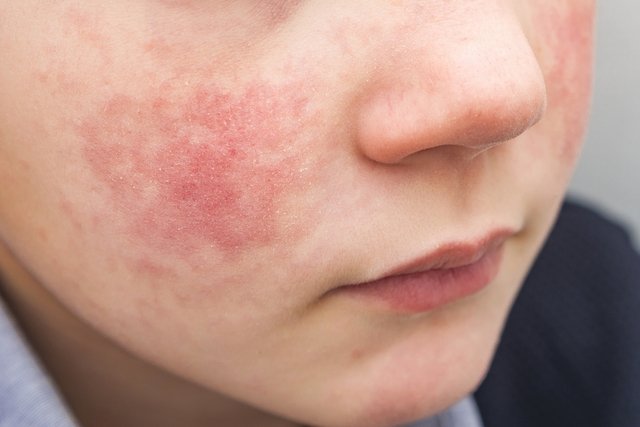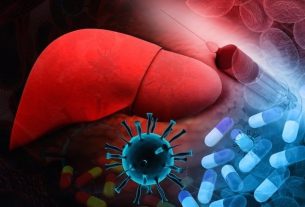Erythema is a condition characterized by the presence of red spots on the skin, which can be caused by conditions such as pregnancy, infections caused by fungi, parasites or bacteria, autoimmune diseases and the use of medications, for example.
Depending on the type of erythema, this condition can also be accompanied by other symptoms, such as bumps on the skin, itching, burning in the area of the spots, headache, low fever, muscle aches and malaise.
Therefore, in the presence of symptoms indicative of erythema, it is advisable to consult a general practitioner, dermatologist or pediatrician, so that the diagnosis can be made and, if necessary, treatment can be indicated, which may include the use of antibiotics, analgesics and anti-inflammatories. oral medications, ointments and the use of supplements.

Main symptoms
The main symptoms of erythema are:
- Red or purple spots on the skin;
- Red dots on hands, face, legs or arms;
- Headache;
- Low fever;
- Discomfort;
- Burning sensation in the region of the lesions;
- Muscle and joint pain.
In addition, the symptoms of erythema, which vary depending on the cause of this condition, may also include itchy skin and increased temperature in the area of the spots.
Types of erythema
There are different types of erythema, depending on the cause of this condition.
1. Erythema nodosum
Erythema nodosum is a condition that arises due to diseases caused by viruses, fungi, parasites or bacteria, such as tuberculosis, leprosy, leptospirosis, infectious mononucleosis, hepatitis B, hepatitis C and amoebiasis. Erythema nodosum can also be caused by conditions such as medication use, leukemia, lymphoma and autoimmune diseases.
Read too: Erythema nodosum: what it is, symptoms, causes and treatment
This type of erythema is characterized by the appearance of red or purple plaques or nodules on the skin, firm, deep and painful to the touch, especially on the shin.
2. Erythema infectiosum
Erythema infectiosum, also called parvovirus, fifth disease or, popularly, slap disease, is a disease caused by the human parvovirus B19, and is common in children between 5 and 7 years old, although it also occurs in older people.
The main symptoms of erythema infectiosum are red spots on the cheeks, trunk, arms and legs, as well as itchy skin, low fever, headache and general malaise. Learn more about the symptoms of erythema infectiosum.
3. Erythema multiforme
Erythema multiforme, or polymorph, is an inflammatory reaction of the skin that causes symptoms such as red spots and blisters that spread across the body, being more common on the hands, arms, feet and legs. However, lesions can also appear on the soles of the feet and inside the mouth.
The conditions that can trigger erythema multiforme lesions are: infection with herpes simplex virus types 1 and 2, bacteria Mycoplasma pneumoniae, adenovirus, Epstein-Barr virus, or parvovirus B19, for example; Use of medicines, such as penicillins, cephalosporins, antipyretics, or antituberculous drugs; and contact with heavy metals.
Read too: Erythema Multiforme: what it is, symptoms, causes and treatment
4. Toxic erythema
Erythema toxicum, or neonatal erythema toxicum, is a common benign condition in newborns characterized by symptoms such as small red spots on the skin shortly after birth or after 2 days of life, mainly on the cheeks, face, chest, arms or legs.
The exact cause of erythema toxicum is not completely known, but it appears to be related to an immunological response that causes skin inflammation due to microbial colonization of the baby’s skin after birth.
5. Fixed pigmentary erythema
Fixed erythema pigmentosa is a skin reaction to oral medications, such as antimicrobials and nonsteroidal anti-inflammatory drugs. Furthermore, antibiotics, herbal supplements, flavorings, preservatives and colorings in food can also cause this type of erythema.
Fixed pigmentary erythema is characterized by red, purple and brown spots, blisters on the skin, mainly on the hands and feet, and on the mucous membrane of the mouth and genitals, which disappear and reappear in the same places on the body whenever the medication is used. In addition, fixed erythema pigmentosa can also cause pain, fever and malaise or serious reactions such as Stevens-Johnson Syndrome.
Read too: Stevens-Johnson syndrome: what it is, symptoms, causes and treatment
6. Palmar erythema
Palmar erythema is characterized by redness at the base of the palm and, eventually, the fingers, which is not itchy or painful, but may feel warm. This condition is caused by increased dilation of the superficial blood vessels of the hand, as can happen in cases of hereditary palmar erythema or during pregnancy.
Furthermore, palmar erythema can also appear due to the presence of some situations, such as cirrhosis, Wilson’s disease, hemochromatosis, rheumatoid arthritis, Kawazaki’s disease, poisoning and atopic dermatitis.
7. Malar erythema
Malar erythema is a flat or raised red patch, shaped like a butterfly, that appears on the nose and cheeks. This type of erythema is mainly seen in people with lupus, an autoimmune disease that causes inflammation in the joints, skin, kidneys, bone marrow, heart, lungs, eyes and brain.
Additionally, malar erythema can also be present in other conditions such as erysipelas, cellulitis, rosacea, pellagra, or dermatomyositis.
8. Erythema marginatum
Erythema marginatum, or erythema marginatum, is a rare condition that causes the appearance of a red spot on the skin, usually located on the trunk and extremities of the body. This type of erythema can appear in some diseases, such as acute or chronic rheumatic fever, psittacosis and hereditary angioedema.
9. Erythema annulare centrifuge
Centrifugal annular erythema is a red, circle- and arc-shaped lesion that appears like hives and increases in size.
Centrifugal annular erythema is believed to be a type of hypersensitivity reaction and may be related to conditions such as athlete’s foot, pregnancy, stress, rheumatic disease, adverse reaction to medications and endocrine changes, for example.
How to confirm the diagnosis
The diagnosis of erythema must be confirmed with a general practitioner, dermatologist or pediatrician, through a complete physical examination and the person’s family and health history.
If you want to confirm the risk of erythema, make an appointment with the general practitioner closest to you:
Taking care of your health has never been easier!
The doctor may also request tests such as blood count, C-reactive protein, chest x-ray, antibody test, serology and stool test. If in doubt, the doctor may request a skin biopsy to confirm the diagnosis and rule out other conditions with similar symptoms.
In addition, the doctor may also perform an oral provocation test, with a low dose of the suspected medication, or a patch test, where the suspected medication is applied to the site of the injury.
Possible causes
Erythema can be caused by conditions such as:
- Infections caused by virusesfungi, parasites or bacteria, such as tuberculosis, parvovirus, psittacosis, hepatitis B, hepatitis C and amoebiasis;
- Autoimmune diseases, such as lupus, rheumatic fever, ulcerative colitis and Crohn’s disease;
- Use of medications, such as penicillin, oral contraceptives and non-steroidal anti-inflammatory drugs;
- Intake of food additives, as flavorings, preservatives and colorings in foods.
Furthermore, erythema can also appear during pregnancy or hereditary, as in the case of hereditary angioedema, a genetic disease in which fluid accumulates outside the blood vessels, causing symptoms such as rapid swelling of the face, hands or feet.
Read too: Hereditary angioedema: what it is, symptoms, causes and treatment
How the treatment is carried out
The treatment of erythema varies depending on the cause of this condition, and may include stopping the use of the medication that causes the condition, or the use of oral medications, ointments or supplements.
1. Oral medications
The use of oral corticosteroids may be indicated for the treatment of fixed pigmentary erythema, malar erythema and centrifugal annular erythema. Analgesics and steroid anti-inflammatories can be recommended to control headache and fever in cases of erythema nodosum and infectiosum.
In cases of erythema caused by streptococcal infection, cellulitis, erysipelas, psittacosis, Mycoplasma pneumoniae or tuberculosis, the doctor may prescribe the use of antibiotics, such as penicillin, erythromycin, azithromycin, doxycycline, rifampicin, isoniazid and pyrazinamide.
2. Ointments or creams
Steroids, in the form of ointments, may be prescribed by the physician for the treatment of fixed erythema pigmentosa and centrifugal erythema annulare.
In the case of erythema multiforme, the use of antiseptic and anesthetic ointments, in addition to the application of petroleum jelly to the lips, may be prescribed to help treat this condition.
In cases of itchy skin, caused by centrifugal annular erythema, for example, the doctor may recommend the use of antihistamines in the form of ointments or creams.
3. Supplements
In cases of malar erythema caused by pellagra, your doctor may recommend the use of oral niacin or nicotinamide supplements. Understand better how pellagra is treated.

Sign up for our newsletter and stay up to date with exclusive news
that can transform your routine!
Warning: Undefined array key "title" in /home/storelat/public_html/wp-content/plugins/link-whisper-premium/templates/frontend/related-posts.php on line 12
Warning: Undefined array key "title_tag" in /home/storelat/public_html/wp-content/plugins/link-whisper-premium/templates/frontend/related-posts.php on line 13



